What are the Different Types of Bandages?
A key part of any first aid kit, bandages are generally used to cover wounds, apply pressure to bleeding wounds and to support and immobilise sprains, strains and broken bones. They’re generally lightweight, flexible and breathable, but different types have different characteristics, and are better suited for various injuries. With such a range of bandages to choose from, it can be confusing to know how to make the right choice.
This simple guide breaks down the different types of bandage, their characteristics, use cases and how to apply them.
There are three main categories of bandage: roller bandages, triangular bandages and tubular bandages.
Roller Bandages
The most common type of bandage, roller bandages are typically made from a continuous strip of lightweight and breathable cotton, and includes crepe bandages, cohesive bandages, conforming bandages and elastic adhesive bandages.
Crepe Bandages
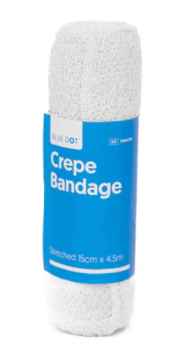
Crepe bandages are typically made from cotton and are thicker, woven bandages that are flexible enough to be wrapped around various parts of the body without difficulty. They’re elasticated, so are strong enough to provide sufficient compression to affected areas, while still being breathable and allowing muscles or joints to flex.
Providing pressure to a limb or joint, most commonly ankle or knee
Holding a dressing in place
Applying pressure to control bleeding wounds
Supporting a strain or sprain
Application method:
Always ensure you’re wearing protective gloves, and have sufficiently cleaned the wound or affected area before applying a bandage.
Gently wind the bandage around the affected area in a diagonal motion, making sure that each new layer covers at least half of the previous layer. With the first layer of bandage, be careful not to apply with too much tension, which could cut off blood flow. The subsequent layers will then provide enough security to hold the bandage in place. Lastly, ensure you have covered below and above the injured area (limb or joint), before cutting the end of the bandage and securing it in place with tape, or the clips provided.
Cohesive Bandages
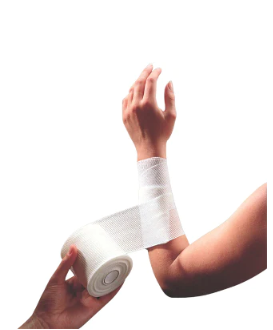
Characteristics:
Thin, versatile and easy to use, cohesive bandages are designed to stick to itself but not to skin or hair. This means it requires no tape or pins to hold in place, and carries no risk of pulling out hairs when removing. They’re woven specifically to allow maximum flexibility, stretching up to double its normal length.
Use cases:
Compressing and supporting strains and sprains
Holding wound dressings in place
Often used in sports like football, to strap fingers, wrists or ankles
Often used on pets and race horses
Application method:
Always ensure you’re wearing protective gloves, and have sufficiently cleaned the wound or affected area before applying a bandage.
Roll out a sufficiently sized piece of bandage, and apply the first layer of the bandage without tension, ensuring that at least half of each wrap is overlapping the layer adjacent to it, to allow it to stick together. Once the first layer is applied, continue to wrap over the injured area, increasing the tension slightly to allow the bandage to be held in place.
Always make sure to check blood flow in the fingers if applied on the arm, wrist or hand, and in the toes if applied to the ankle or foot. Do this by pressing the toe or finger for five seconds until it loses its colour, once released the colour should return within two seconds. If it doesn't, unwrap the bandage and apply with less tension.
Conforming Bandages
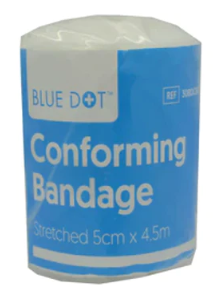
Characteristics:
Conforming bandages have a similar appearance to cohesive bandages, however require tape to hold them in place. As their name suggests, this type of bandage conforms closely to the body while being highly flexible and breathable. They’re usually made with synthetic materials, and are fray resistant and secure—a great option for applying pressure.
Use cases:
Holding a dressing in place
Applying pressure to control bleeding wounds
Compressing and supporting a strain or sprain
Application method:
Always ensure you’re wearing protective gloves, and have sufficiently cleaned the wound or affected area before applying a bandage.
For general application, place the gauze (if using) over the wound and begin wrapping the bandage twice around the injury to hold it in place. Move your way up the limb, wrapping the bandage and ensuring that each new layer covers half of the previous layer. Complete by wrapping the bandage around once more and securing in place.
If using conforming bandages on elbows or knees to support strains or sprains—or to hold dressings in place—lightly flex the joint and apply the bandage in a figure of 8 motion.
If using conforming bandages on hands to support strains or sprain— or to hold dressings in place—begin from the inside of the wrist and wrap across the back of the hand diagonally to the end of the little finger, while leaving the thumb free.
Elastic Adhesive Bandages
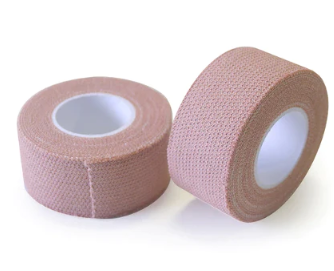
Characteristics:
Elastic adhesive bandages are extremely adhesive and sticky, and are designed to be taped directly onto the skin. They are generally thick, and heavier in weight than other roller bandages. They provide more stability and rigidity, but may not be suited to injuries to areas where range of motion is highly important.
Use cases:
Compressing and supporting a strain or sprain by applying to a joint.
Applying over a conforming, cohesive or crepe bandage to provide additional pressure to control bleeding wounds.
Application method:
Always ensure you’re wearing protective gloves, and have sufficiently cleaned the wound or affected area before applying a bandage. Unroll a sufficient amount of elastic adhesive bandage, wrapping around the affected area. Due to its thickness, the area may only require one layer of bandage.
Triangular Bandages
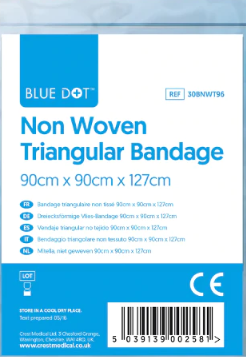
Characteristics:
Triangular bandages are one of the most versatile options, as they are usually a very large single sheet of thick cotton that can be shaped to suit a range of injuries. They’re large in size, provide great stability and are a key part of any first aid kit.
Use cases:
Supporting broken bones, dislocations and soft tissue injuries as a sling
Providing protection for head injuries
Acting as a tourniquet, in rare situations where this is required (i.e severe bleeding cannot be stopped, and creating a tourniquet cuts off the blood supply to the affected area)
It is important to remember that treating bleeding injuries doesn't require a tourniquet in most cases. However, recent studies have shown that early use of a tourniquet can save lives. If the bleeding can’t be stopped, and a tourniquet is necessary, a triangular bandage will work highly effectively.
Application method:
Always ensure you’re wearing protective gloves, and have sufficiently cleaned the wound or affected area before applying a bandage.
There are a number of ways to apply a triangular bandage, including arm slings, elevated slings, broad-fold and narrow-fold bandages, and pads. The location on the body, and severity of injury will determine how to use the triangular bandage, as explained below:
Arm sling
Ask the patient to support their arm horizontally with their other hand. Carefully guide the bandage under the arm, with the point of the triangle resting underneath the elbow of the injured arm. Bring the top of the bandage around the back of the patient’s neck.
Following this, loop the lower end of the bandage up over the arm to meet the top of the bandage at the shoulder of the injured side. Tie these ends of the bandage together in a reef knot above the collar bone.
Adjust the sling to ensure it covers their full arm and hand, and fasten the end of the bandage by the elbow with a safety pin, or twist the fabric and tuck it in. Ensure to check circulation in the fingertips every 10-15 minutes, by pressing their nail for 5 seconds until it becomes pale. Then, release and check if the colour returns within 2 seconds.
Elevated sling
Some injuries will require the arm to be elevated. If this is the case, ensure the patient creates the elevated angle with their affected arm, and follow the same steps as above.
Broad-fold bandage
Broad-fold bandages are mainly used for lower-body injuries. They’re created by folding the point of the triangle down to the base twice, which allows them to be looped around the affected area to create a supportive, circular bandage.
Narrow-fold bandage
Narrow-fold bandages can also be used to support lower-body injuries, to suppress bleeding, and as a collar-and-cuff sling for upper body injuries. It is created by folding a broad-fold bandage again.
Pad
If you’re needing a large dressing for a major wound, create a pad from the triangular bandage by folding each corner into the centre three times, or as many/little as necessary for the size of the wound.
Tubular Bandages
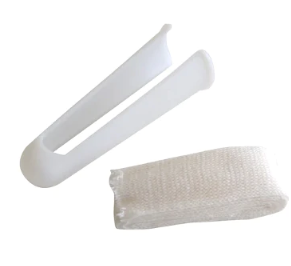
Characteristics:
Tubular bandages are often used to support and secure dressings on fingers and toes, due to their size and ability to allow freedom of movement. As their name suggests, they’re shaped like a tube, which gives them unique use cases. They’re elasticated and made from cotton, and don’t require tapes or pins to hold in place.
Use cases:
Holding dressings on fingers, toes, or other affected areas
Supporting injured joints
Protecting skin under a cast of a broken bone
Application method:
When using a tubular bandage, it is important to ensure you have the correct size, whether that be for a toe, finger or any other region of the body. If you can, use a plastic tube applicator to help with the treatment. Place the bandage on the applicator, rolling it down and ensuring it is fully loaded on. From here, stretch the applicator adjacent to the area you wish to apply the bandage to, and roll it on gently, with care for the injury. If this is over the top of a dressing, ensure that it hasn’t been moved in the process.